Your overhead door does more than just provide entry and exit; it protects your home, boosts energy efficiency, and enhances curb appeal. But like any complex equipment, it needs maintenance. Ignoring subtle issues can lead to expensive fixes—or worse, a door that stops working entirely. Let’s explore the top 5 signs your overhead door might need repair and why acting quickly is essential.
1. Unusual Noises During Operation
Does your overhead door creak, grind, or screech? These sounds are not just annoying—they’re a warning sign. Unusual noises can indicate issues with the door’s torsion springs, rails, or opener system. Left unchecked, these small problems can escalate into serious breakdowns.
Delayed Garage Door Movement
If your overhead door takes its sweet time open or close, it might be due to aging parts or problems with the system. A door that delays could be dangerous, especially if it fails while in use. Timely intervention can get it back to working efficiently.
Uneven Door Panels
Have you noticed misaligned or drooping areas in your overhead door? This is often a sign of structural weakness or problems with the springs. Beyond being unattractive, sagging can compromise your door’s security and efficiency.
Energy Inefficiency: A Hidden Cost
A poorly sealed or damaged overhead door can cause drafts, making your HVAC system work harder. If you’ve noticed your energy bills rising unexpectedly, your garage door could be the culprit. Fixing your door can help lower costs in the long run.
Signs of Wear and Tear
Dents, splits, or corrosion are clear indicators that your overhead door has been through a lot. While some damage might appear minor, it can lead to bigger issues and make it more susceptible to malfunctions. Addressing these issues without delay is essential for secure operation and performance.
